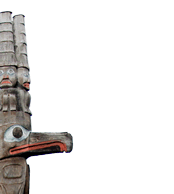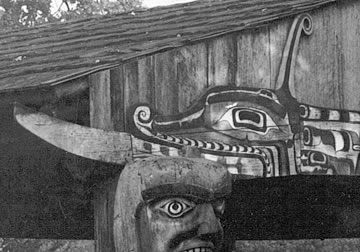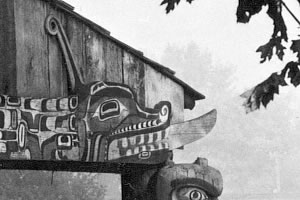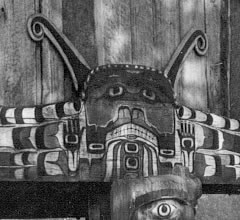 |
|||||||||
 |
|||||||||
 |
|||||||||

Kwakwaka’wakw (ławiťsis or ‘Namgis) Sisiyutł Carving, 19th century |
|
 Thunderbird
Park, ca 1949. RBCM PN 13259. Thunderbird
Park, ca 1949. RBCM PN 13259. |
|
| Charles F. Newcombe purchased this representation of a Sisiyutł,
a supernatural double-headed serpent, in 1913, either at the ławiťsis
village of Kalugwis on Tournour Island or at the ‘Namgis
community of ‘Yalis (Alert Bay). He recorded that it
was part of a chief’s settee and depicts an incident in the
life of a man called Kasayapa-loqu, who was an ancestor of the seller’s
family: Kasayapa-loqu came across a Sisiyutł while hunting in the
woods. He saw four horns coming out of the ground, then the double
heads, and fell down ‘as if dead.’ A man came to him
in a dream and explained that the Sisiyutł was given to him to use
in feasts and potlatches. When he awoke, the Sisiyutł had disappeared
but Kasayapa-loqu made a copy in wood and placed it at the rear of
his house. Then, he gave a grease feast (featuring the valuable oil
of the eulachon fish) and invited all the people. He was the first
person to bring the people together for a feast. The Sisiyutł carving
was moved to Wawadiťła, the Mungo Martin House in Thunderbird Park,
when it was constructed in 1953. RBCM 1857. |
|
 Thunderbird
Park. Trio Crocker photograph. RBCM PN 11688. Thunderbird
Park. Trio Crocker photograph. RBCM PN 11688. |
Sisiyutł, a supernatural double-headed snake. Each head has horns that curl at the ends, a mouth with teeth and a protruding tongue. |
 Thunderbird Park. Trio Crocker photograph. Thunderbird Park. Trio Crocker photograph.RBCM PN 11688. |
The U-shaped forms on its body indicate scales. |
 Thunderbird Park. Trio Crocker photograph. Thunderbird Park. Trio Crocker photograph.RBCM PN 11688. |
As is customary in representations of the Sisiyutł, a third head appears in the centre of the creature. Here, the central head is part of a human-like figure with upraised hands. |
 Thunderbird Park. Trio Crocker photograph. Thunderbird Park. Trio Crocker photograph.RBCM PN 11688. |
A Sisiyutł can cause death for people who do not have supernatural protection but it can also bestow wealth and power. Its blood can make skin as hard as stone; it can become a canoe; its eyes, when thrown from a sling, can kill whales. |
 Thunderbird Park, ca 1949. RBCM PN 13259. Thunderbird Park, ca 1949. RBCM PN 13259. |
|
| Back to Open-sided Building |
